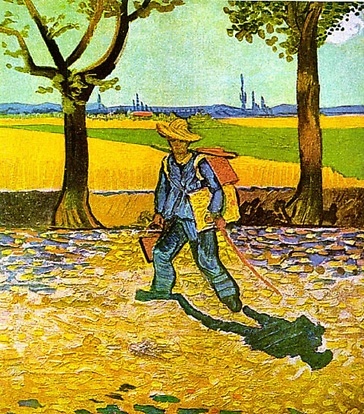
Painter on the Way to Tarascon, Van Gogh, 1888
I walked out of Master’s Market at Ananda Village on a summer day in 1978, wondering how I could make the money to buy a new camera.
Digging in my jeans pocket, I found thirty-four cents – the extent of my net worth. We lived simple lives, free of electricity and indoor plumbing, just kerosene lanterns and outhouses. I worked at the community’s publishing company, where I made $50 dollars a month plus rent.
I said, “Divine Mother, I think a new camera would be helpful for the community. I’ll happily work to make the money, if you’ll tell me how.”
The next day, I got a call from a friend, a physician in San Francisco who, when not seeing patients, was a drop-dead crazy endurance cyclist. He said, “I’ve written a book for cyclists and I need some photos. Can you do them for $500?” It was enough to buy the camera and a decent lens.
Swami Kriyananda had a realistic view of the world that could be a little daunting at times, as when I heard him observe that people in the arts tend not to make a lot of money in their lives. I can only guess at the mechanism; perhaps it’s because we just don’t care. Given the choice, we’d rather chase inspiration than invest a lot of time and energy piling up a mound of shekels.
I’m blown away by ordinary people who use cameras to do wonderful things, without any expectation of getting paid:
- Yelena Shumilova’s photos of her children on a Russian farm.
- Jakub Ostrowski’s portraits of strangers.
- Sleeping Angels
- Glücklichsein
Now, almost forty years after I prayed for the camera, I’ve upgraded my photo gear once again, in hopes of taking better pictures in the dim light of early morning meditations and evening ceremonies at our temple.
Confronting the mountain of lenses that Canon offers, I decided to keep my gear as simple as possible – I would carry just two functional, good-quality zoom lenses.
 Then, after service one Sunday, Nayaswami Lilavati asked me to take her portrait. She had been initiated the night before and needed a photo in her nun’s habit.
Then, after service one Sunday, Nayaswami Lilavati asked me to take her portrait. She had been initiated the night before and needed a photo in her nun’s habit.
We stepped out onto a covered temple porch. It was raining buckets, the day was dark, and the porch was gloomy. No telling what we would get. But the pics turned out reasonably well, and it got me to thinking: what if I could take portraits of lots of Ananda people whose faces were burnished by years of meditation? Maybe I could put the photos together with the stories of how they came on the spiritual path.
As I researched the best lenses for portraiture, it didn’t take long to realize that the Canon 135mm F2 is God’s own gift to photographers for taking people pictures. In the list above, the first two photographers use that lens almost exclusively.
Trouble was, I didn’t have a penny to spare.
In my book of stories about Swami Kriyananda – a work in progress – I tell how, in the early 2000s, I went through an extremely trying period of financial lack. I had a tremendous resume and whacking-good work samples, but I couldn’t get hired even though I applied for hundreds of jobs. People would express great enthusiasm for my services, and then they would drift away. A Vedic astrologer told me, “You’re on pilgrimage. This is a time in your life when the stars are aligned for introspection. You’re basically invisible to employers.” Swell.
The period of testing stretched to about six years. Toward the end, I had a vision in meditation. I saw a young man who stood before a crude rock hut high in the Himalayas. He wore a rough reddish-brown robe, and it was clear that he had absolutely nothing, just a roof over his head and enough food. Yet his face was split with a smile of transcendent blissfulness. I realized that it was possible to be very happy, with hardly any money at all.
Soon after the vision, I wrote an email to Swami Kriyananda. I said, “I have come to understand that I am in this world for just three reasons: to love God, to serve His work, and to live simply.”
A week passed, during which the landlord threatened to throw me out on the street. I didn’t hear from Swami, nor did I expect to receive an answer to my email. Yet I knew that I had gained an abiding and precious understanding. Even if I became homeless, I felt that I could take comfort in that realization, knowing that I had given my life to God, and that my fate was safely in his hands.
Another week passed, and then I got an email from Swamiji’s secretary. He said, “Swami read your note and said, ‘Very good.’”
I’ll say this straight-up and without sentiment or exaggeration: those were the most thrilling words of my life.
The sequel is that, starting early the next morning, the phone began to ring off the hook. Every fifteen minutes, s omeone was calling to offer me work.
omeone was calling to offer me work.
I’ll end the story there. Suffice it to say that in my mind, art and survival are more tightly intertwined than ever with the spiritual life. I had realized that every cent in the cosmos is contained wholly and entirely in Divine Mother’s purse.
Oh, about that expensive Canon lens. I didn’t have a hope of buying it, but I couldn’t stop feeling that it would help show the fruits of a life of meditation. So I prayed again, telling Divine Mother that if she wanted us to do the project together, I would be delighted to take on the work to raise the money, but she would have to provide the opportunity.
Perhaps you’ve guessed the sequel. The next day, a client gave me a substantial assignment. It wouldn’t pay nearly enough to buy the lens, but more or less as an afterthought, she invited me to invoice her for an additional $750 as an advance on future work. The lens cost $820, and I could easily pay the difference out of the proceeds from selling a lens that I no longer needed.
If you’re following the artist’s path, and you aren’t much attuned to a bean-counter’s state of mind, these experiences would appear to suggest that you might find it helpful to hitch your financial star to the chariot of divine grace. Couldn’t hurt. Might help. Who knows?

10 Comments
I want to see those photos of Lilavati et al! You’ve got us tantalized! Keep us posted. :-)
Love this, Rambhakta. And also the idea of portraits of meditators. If you have watched “Into Great Silence” you will know that the most mesmerizing part of the documentary are the times when the camera just has a monk gaze into the camera for 15 seconds. Those eyes from a lifetime of prayer – they can make your heart swell.
Thank You for sharing this, I often feel this way about my life right now – that this is a time of introspection. I’ve come here to serve , and God will always provide. Your story just affirms it for me. Look forward to these pictures.
Namaste
Wonderful story Rambhakta!
Beautiful story, beautiful writing, beautiful soul. Thank you!